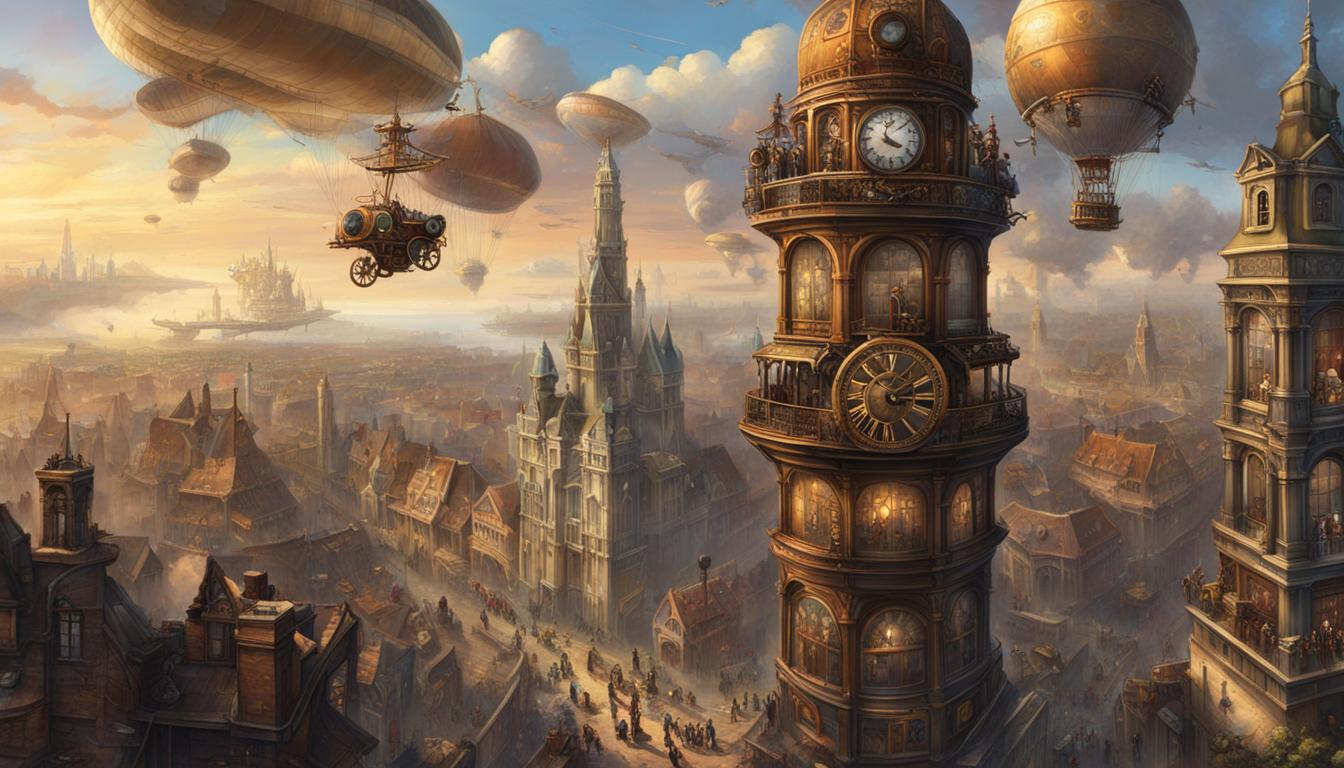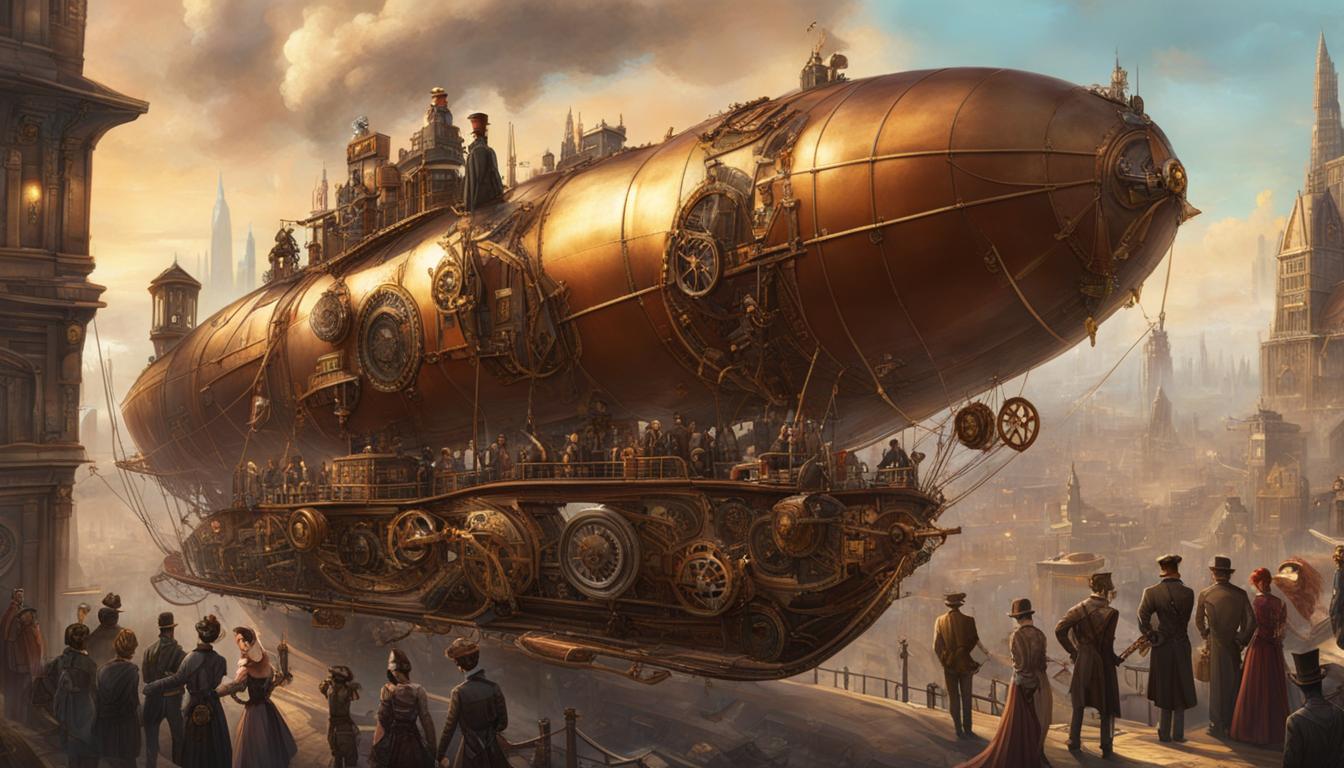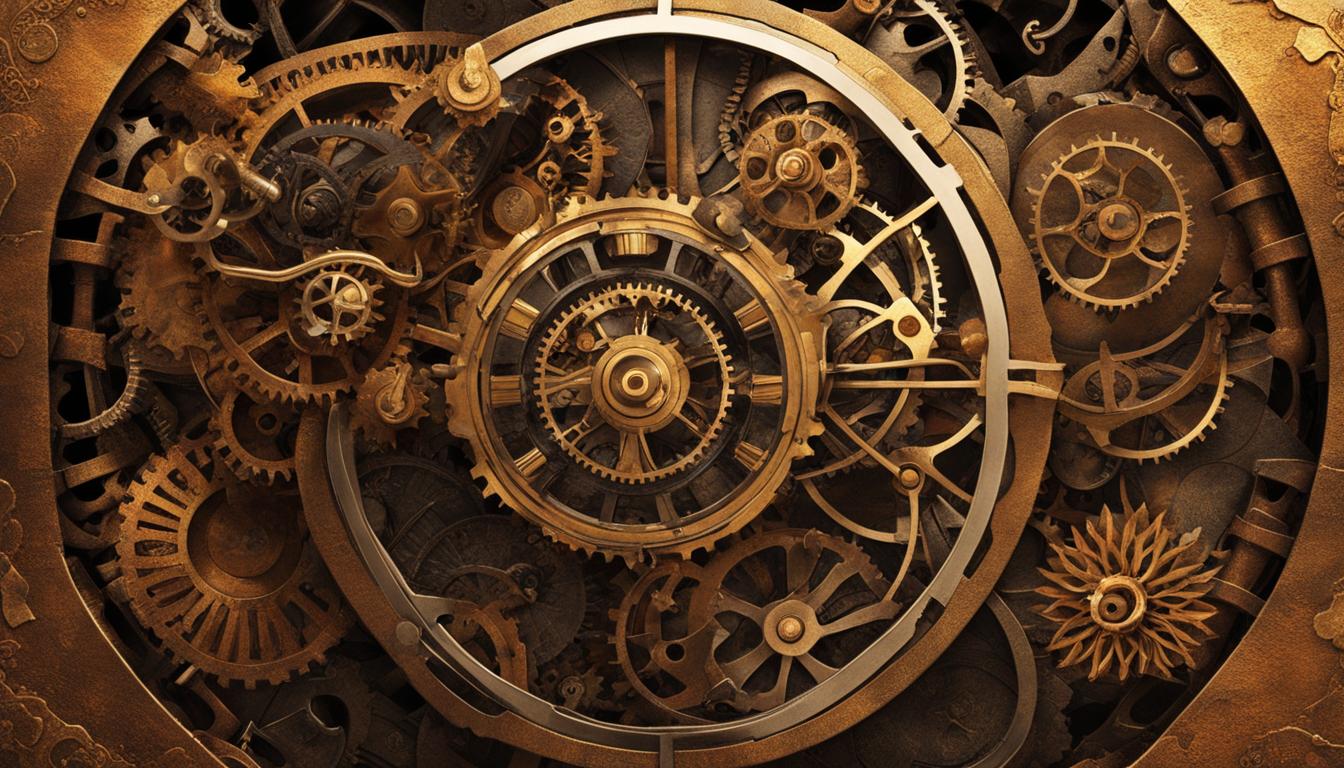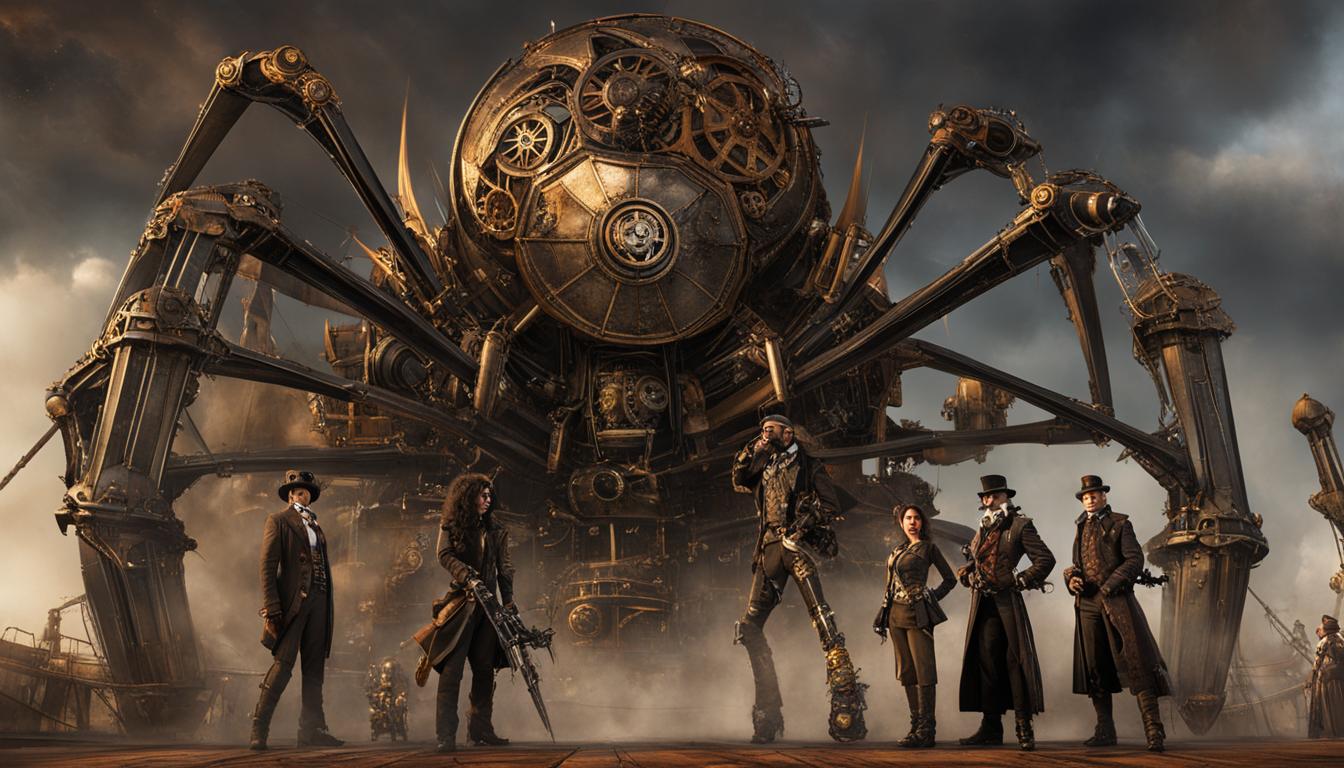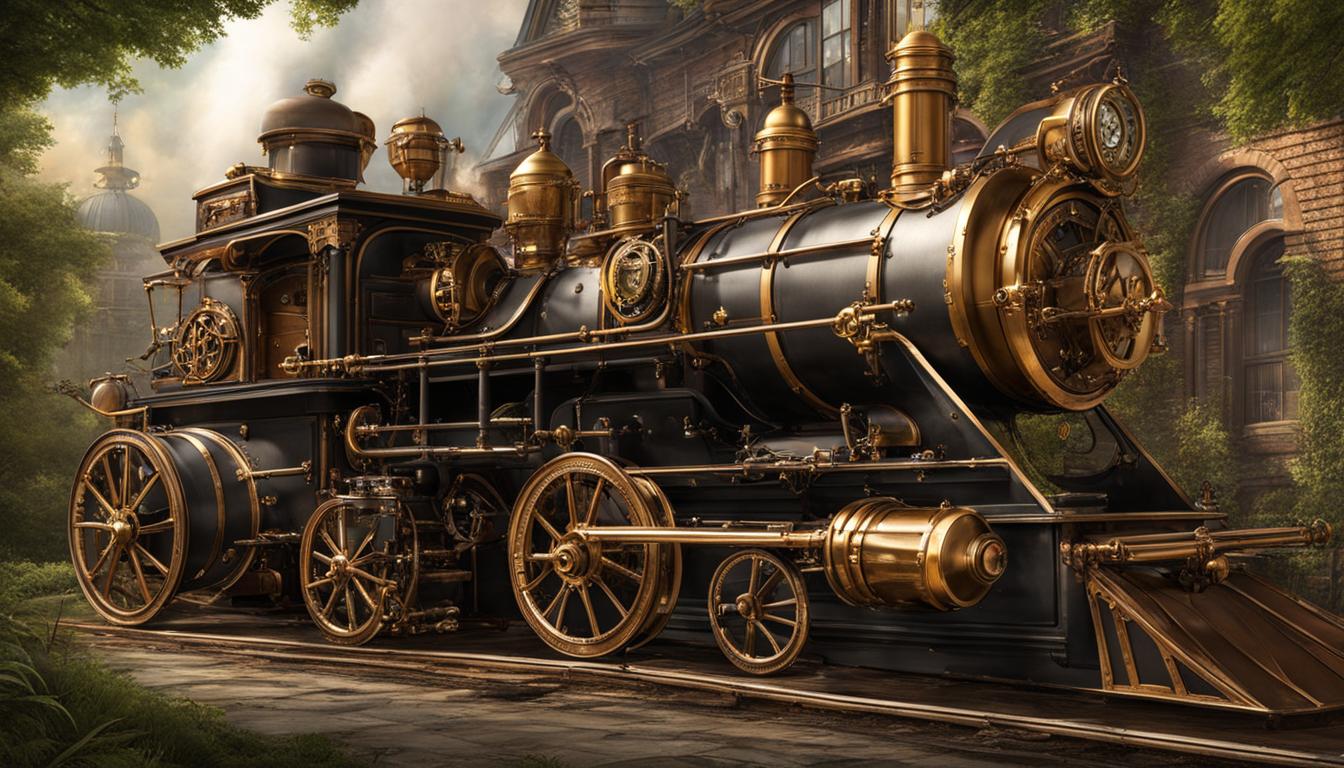Steampunk, a subculture rooted in science fiction and fantasy literature, offers a unique blend of Victorian-era style and steam-powered technology. It reimagines history by crafting alternative narratives that combine elements of the past and future. This movement has gained popularity in recent years, inspiring creativity and innovation in art, fashion, and more. Through its alternative history takes, steampunk reshapes how we perceive and understand historical events.
Key Takeaways:
- Steampunk is a subculture that combines Victorian-era style and steam-powered technology.
- It reimagines history through alternative narratives, blending elements of the past and future.
- Steampunk has inspired creativity and innovation in art, fashion, and various other fields.
- By reshaping historical events, steampunk challenges our perception and understanding of the past.
- The movement continues to grow in popularity and is likely to inspire new trends and impact global culture.
Historical Context: Victorian Era Influence
The Steampunk Movement draws heavily from the Victorian Era, a period of significant social and economic changes. This era, spanning from the 1830s to the early 1900s, saw the rise of the British Empire and the Industrial Revolution. It was a time of strict social hierarchy, with a clear divide between the upper and lower classes. The influence of the Victorian era on steampunk can be seen in its adoption of Victorian aesthetics and societal structures.
Within the steampunk genre, characters often reflect the rigid social hierarchy of the Victorian era. The wealthy aristocrats, dressed in elaborate and opulent attire, are contrasted with the working-class citizens, who usually occupy the lower rungs of society. This portrayal highlights the class divide that was prevalent during the Victorian era.
Furthermore, the Industrial Revolution, a major historical event during the Victorian era, greatly influences the steampunk movement. The development of steam-powered machinery, factories, and the expansion of railway networks are all recurring themes in steampunk literature, art, and fashion. The combination of Victorian aesthetics and steam-powered technology is a defining feature of the steampunk genre.
Table: Victorian Era Influences on Steampunk
| Aspect | Description |
|---|---|
| Social Hierarchy | Steampunk portrays the strict class divisions of the Victorian era, with wealthy aristocrats and working-class citizens. |
| Industrial Revolution | The development of steam-powered machinery, factories, and railway networks are recurring themes in steampunk. |
| Aesthetics | Steampunk adopts the intricate and ornate Victorian fashion and design elements. |
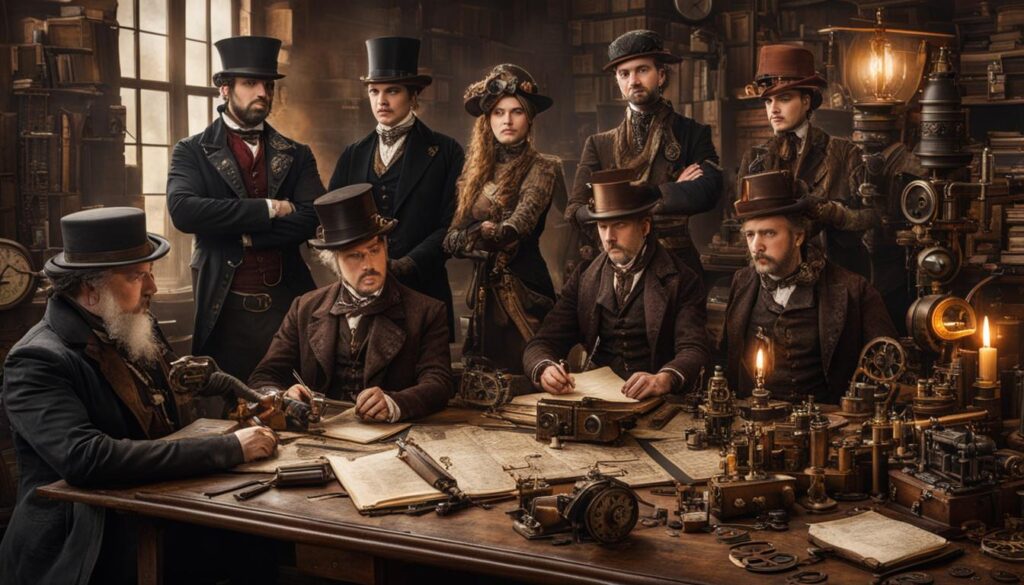
One cannot discuss steampunk without acknowledging the profound impact of William Gibson and Bruce Sterling. Their collaboration in the novel “The Difference Engine” in 1990 brought the genre to the forefront of popular culture, further solidifying its place in the literary world. The book presents an alternative history where Charles Babbage’s mechanical computer, the Analytical Engine, was successfully developed, leading to a Victorian society driven by advanced steam-powered technology.
The Difference Engine is widely regarded as a seminal work in the steampunk genre, providing readers with a rich tapestry of Victorian aesthetics and an alternate history brimming with mechanical marvels.
The Influence Spreads Beyond Literature
While steampunk originally emerged from the pages of books, its impact soon reached far beyond the realm of literature. Filmmakers, such as the creators of “The League of Extraordinary Gentlemen,” brought steampunk to the silver screen, captivating audiences with its visually stunning blend of historical elements and fantastical machines. The music scene also embraced the steampunk aesthetic, with bands like Abney Park and The Cog is Dead infusing their music with themes and imagery inspired by the genre.
The contributions of these key figures, both in literature and other creative mediums, have played a significant role in the rise and continued popularity of steampunk. Their work has helped shape and define the unique aesthetic and narrative elements that make steampunk such a captivating and enduring genre.
| Key Figures in Steampunk | Contributions |
|---|---|
| Jules Verne | Explored themes of technology and adventure in works such as “20,000 Leagues Under the Sea” and “Journey to the Center of the Earth.” |
| H.G. Wells | Pioneered the concept of time travel in “The Time Machine” and introduced themes of alien invasion in “War of the Worlds.” |
| William Gibson and Bruce Sterling | Collaborated on “The Difference Engine,” a novel that presented an alternative history with advanced steam-powered technology. |
| The creators of “The League of Extraordinary Gentlemen” | Brought steampunk to the silver screen with their visually stunning adaptation of Alan Moore’s graphic novel series. |
| Abney Park and The Cog is Dead | Infused their music with steampunk themes and imagery, contributing to the genre’s vibrant music scene. |
Steampunk in Literature
Steampunk literature is a genre that embraces the fusion of Victorian aesthetics with futuristic technology, creating captivating narratives that transport readers to alternative worlds. Classic steampunk works have left an indelible mark on the genre, drawing inspiration from influential authors such as H.G. Wells and the iconic television series “Wild Wild West.” These works have paved the way for contemporary masterpieces that continue to push the boundaries of steampunk storytelling.
One of the most significant influences on steampunk literature is the work of H.G. Wells, particularly his novel “The Time Machine.” In this timeless classic, Wells explores themes of time travel and advanced technology set against the backdrop of a Victorian-era society. This exploration of the relationship between science and society, combined with the imaginative reimagining of historical events, has become a hallmark of the steampunk genre.
“The past is but the beginning of a beginning, and all that is and has been is but the twilight of the dawn.”
The television series “Wild Wild West” from the 1960s has also had a lasting impact on steampunk literature. The show’s anachronistic technology and gadgets, paired with its Western setting, have influenced countless authors to incorporate similar elements into their own steampunk works. The fusion of genres and the juxtaposition of historical and futuristic elements create a sense of wonder and intrigue that captivates readers.
In contemporary times, authors like Tim Powers and Scott Westerfeld have embraced the steampunk aesthetic, producing masterful works that reimagine historical events with a steampunk twist. Powers’ novel “The Anubis Gates” combines time travel, magic, and Victorian London, while Westerfeld’s “Leviathan” series reimagines World War I with Darwinian genetic engineering and fantastical steam-powered machines. Their contributions to the genre have pushed the boundaries of what steampunk literature can achieve, captivating readers with their imaginative storytelling.
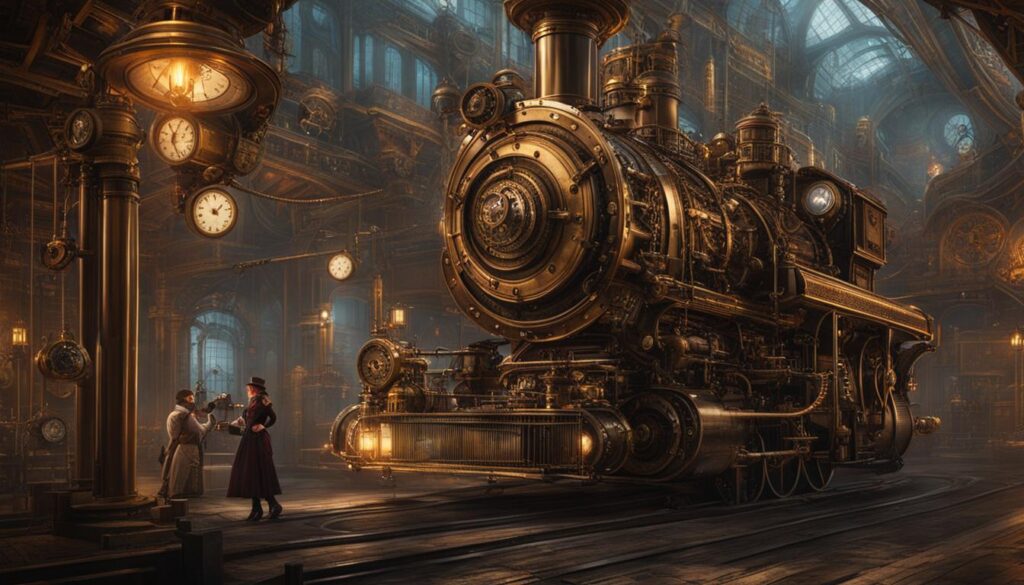
The Steampunk Canon: Classic Works and Contemporary Masterpieces
| Classic Steampunk Works | Author |
|---|---|
| “The Time Machine” | H.G. Wells |
| “20,000 Leagues Under the Sea” | Jules Verne |
| “The Anubis Gates” | Tim Powers |
| “Leviathan” | Scott Westerfeld |
Steampunk in Visual Media
Steampunk has made its mark in film and television, captivating audiences with its unique blend of Victorian-era style and technology. Productions like “Wild Wild West” and the BBC’s “Sherlock Holmes” series have incorporated steampunk elements into their design and storytelling, immersing viewers in a world where steam-powered machinery and gadgets coexist with the fashion and elegance of the 19th century.
Art and design also play a significant role in bringing the steampunk aesthetic to life. From intricate steampunk-inspired fashion to architectural marvels, artists and designers have embraced the creativity and craftsmanship required to encapsulate the essence of the movement. The attention to detail in these works showcases the dedication and passion of those who contribute to the visual aspect of steampunk.
“Steampunk combines the beauty of the past with the ingenuity of the future, creating a visual experience that transports viewers to a world unlike any other,” says renowned steampunk artist, Isabella Brass. “The genre allows us to reimagine history, blending historical elements with the fantastical, and the visual media has been instrumental in bringing this world to life.”
Furthermore, the steampunk aesthetic brings a sense of wonder and adventure to the screen. It evokes a sense of curiosity and exploration, inviting audiences to embark on thrilling journeys through an alternate reality. The visual media’s portrayal of steampunk not only entertains but also serves as an inspiration for countless artists and designers who seek to create their own unique interpretations of this captivating movement.
Table: Steampunk in Film and Television
| Film/TV Show | Release Year | Steampunk Elements |
|---|---|---|
| “Wild Wild West” | 1999 | Anachronistic technology, steam-powered gadgets |
| “Sherlock Holmes” (BBC Series) | 2010-present | Victorian-era aesthetic, steam-powered inventions |
| “The League of Extraordinary Gentlemen” | 2003 | Victorian-era setting, steampunk gadgets |
Steampunk’s visual presence in film, television, art, and design has left an indelible mark on popular culture. Its ability to blend the elegance of the past with the innovation of the future continues to captivate audiences and inspire creators around the world.
Steampunk Aesthetic and Fashion
Steampunk fashion is a captivating blend of Victorian-era aesthetics and futuristic mechanical elements. Enthusiasts of the steampunk movement express their creativity through elaborate costumes, accessories, and even gadgets and decor. The attention to detail and intricate designs in steampunk fashion showcase the craftsmanship and imagination of its followers.
Steampunk fashion incorporates iconic Victorian-era garments such as corsets, top hats, and waistcoats, often with a twist. These traditional pieces are paired with unique and imaginative accessories that give steampunk fashion its distinct look. Goggles, gears, clockwork-inspired jewelry, and ornate brooches are commonly seen in steampunk outfits, adding a touch of the mechanical and futuristic.
While steampunk fashion draws inspiration from the past, it also embraces modern elements. Steampunk enthusiasts often experiment with combining vintage pieces with modern materials or incorporating technology into their outfits. For example, some steampunkers create functional gadgets like pocket watches or modified electronic devices that are intricately designed to match the aesthetic.
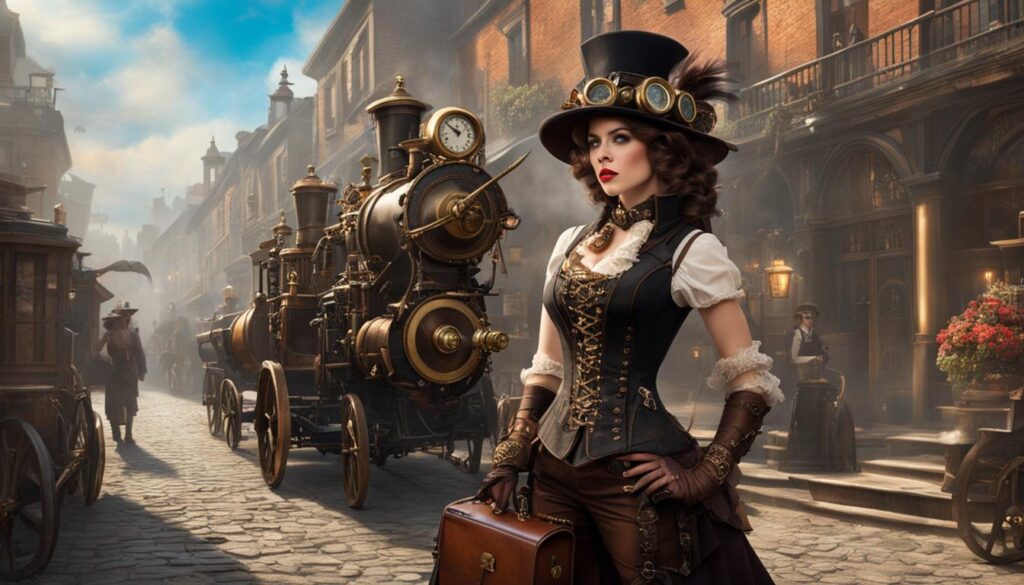
Steampunk fashion is not limited to clothing alone; it extends to home decor and gadgets as well. Steampunk enthusiasts often adorn their homes with Victorian-inspired furniture and decor, incorporating gears, cogs, and other mechanical elements. Steampunk gadgets, such as ornate retro-futuristic lamps and intricate clockwork sculptures, add an air of whimsy and charm to any steampunk enthusiast’s living space.
The steampunk movement continues to inspire and push the boundaries of fashion and design. Its unique blend of historical aesthetics and futuristic elements has captivated the imagination of people around the world. Steampunk fashion allows individuals to express their creativity and embrace an alternative version of history that combines past and future in a visually captivating way.
Steampunk Subcultures
Steampunk has evolved into a vibrant subculture that extends beyond literature and visual media. It has its own thriving music scene, with bands like Abney Park and The Clockwork Quartet captivating audiences with their unique blend of Victorian-inspired melodies and futuristic sounds. The music scene in steampunk offers a distinct and immersive experience, transporting listeners to a world where steam-powered machinery and timeless elegance coexist.
“Steampunk music combines the nostalgia of the past with the excitement of the future,” says Professor Amelia Morgan, a cultural historian. “It’s a genre that invites listeners to immerse themselves in a world of mechanical wonders and fantastical adventures.”
One of the highlights of the steampunk calendar is the various conventions held around the world, where enthusiasts gather to celebrate their shared love for this unique subculture. These conventions serve as a hub for artists, authors, cosplayers, and fans to connect, showcase their work, and participate in a wide range of activities. From panel discussions and workshops to fashion shows and live performances, steampunk conventions offer a diverse and immersive experience for attendees.
Cosplay, or costume play, is an integral part of the steampunk community. Steampunk enthusiasts go to great lengths to meticulously recreate the elaborate costumes and accessories of their favorite characters from literature, film, and television. The attention to detail and craftsmanship displayed in their costumes is a testament to the dedication and passion of the steampunk community.
The Steampunk Music Scene
The music scene in steampunk is a captivating blend of Victorian-inspired melodies and futuristic sounds. Bands like Abney Park and The Clockwork Quartet have carved out a niche within the genre, captivating listeners with their unique compositions. Steampunk music transports audiences to a world where the clanking of gears and the hiss of steam become melodic, inviting them to immerse themselves in a mix of nostalgia and excitement.
Steampunk Conventions: Celebrating the Subculture
Steampunk conventions are a highlight of the subculture’s calendar, bringing together enthusiasts from around the world. These events serve as a gathering place for artists, authors, cosplayers, and fans to connect, share their work, and participate in a wide range of activities. From panel discussions and workshops to fashion shows and live performances, steampunk conventions offer a vibrant and immersive experience for attendees.
The Art of Steampunk Cosplay
Cosplay is a beloved activity within the steampunk community, where enthusiasts meticulously craft costumes and accessories inspired by their favorite characters from literature, film, and television. The attention to detail and craftsmanship displayed in steampunk cosplay is a testament to the dedication and passion of its followers. From intricate corsets to elaborate gadgets, steampunk cosplayers embody the spirit of the movement through their creativity and love for the genre.
Steampunk Cosplay
| Character | Source |
|---|---|
| Airship Pilot | “Leviathan” by Scott Westerfeld |
| Mad Scientist | “The Invisible Library” by Genevieve Cogman |
| Steampunk Adventurer | “The Difference Engine” by William Gibson and Bruce Sterling |
| Victorian Detective | “The Strange Case of Dr. Jekyll and Mr. Hyde” by Robert Louis Stevenson |
Conclusion
The Steampunk Movement has sparked a wave of creativity and innovation, reshaping how we perceive history and inspiring artistic expression in various forms. With its unique fusion of Victorian-era style and steam-powered technology, Steampunk has made a global impact, captivating the imaginations of people around the world.
From literature to visual media, Steampunk’s influence can be seen in the reimagining of historical events and the incorporation of anachronistic gadgets and aesthetics. Classic works by literary pioneers like Jules Verne and H.G. Wells, as well as contemporary masterpieces, have contributed to the expansion of the Steampunk literary canon.
Steampunk’s reach extends beyond the pages of books and into the realms of film, television, and art. Productions like “Wild Wild West” and the BBC’s “Sherlock Holmes” series have embraced the Steampunk aesthetic, while artists and designers have created intricate Steampunk-inspired fashion, architecture, and artwork.
As the Steampunk Movement continues to evolve, it is likely to inspire emerging trends, pushing the boundaries of creative expression even further. The future of Steampunk holds endless possibilities, as enthusiasts and creators around the globe continue to immerse themselves in this captivating subculture.
FAQ
How does steampunk reshape history?
Steampunk offers alternative narratives that combine elements of the past and future, reimagining historical events with its unique blend of Victorian-era style and steam-powered technology.
What is the influence of the Victorian era on steampunk?
The strict social hierarchy and class divide of the Victorian era are reflected in the portrayal of characters within the steampunk genre. Additionally, the Industrial Revolution and steam-powered machinery play a significant role in steampunk aesthetics and themes.
Who are the key figures in the steampunk movement?
Steampunk draws heavily from the works of Jules Verne and H.G. Wells, who explored themes of technology and exploration. Authors like William Gibson and Bruce Sterling have also popularized the steampunk aesthetic with their works.
What are some classic steampunk works?
H.G. Wells’ “The Time Machine” and the 1960s television series “Wild Wild West” have influenced the steampunk genre. Contemporary authors like Tim Powers and Scott Westerfeld have also made significant contributions to steampunk literature.
How does steampunk manifest in visual media?
Films and television shows like “Wild Wild West” and the BBC’s “Sherlock Holmes” series incorporate steampunk elements into their design and storytelling. Art and design also embrace the steampunk aesthetic, inspiring intricate steampunk-inspired fashion, architecture, and artwork.
What is the steampunk fashion aesthetic?
Steampunk fashion combines Victorian-era aesthetics with mechanical and futuristic elements. It features elaborate costumes, accessories like corsets and top hats, and incorporates gears and goggles. The attention to detail showcases the creativity and craftsmanship of steampunk enthusiasts.
What are some aspects of steampunk subcultures?
Steampunk has a dedicated music scene, with bands like Abney Park and The Clockwork Quartet. Steampunk conventions bring together enthusiasts from around the world, where attendees often dress up in elaborate costumes. Cosplay, or costume play, is a popular activity within the steampunk community.
What is the future of steampunk?
Steampunk continues to inspire creativity and innovation in various forms of expression. Its impact on global culture is likely to grow, with emerging trends and new influences shaping the movement.

